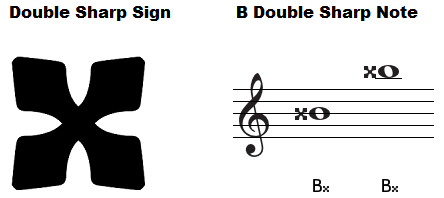While a sharp raises a a note’s pitch by a half tone, a double sharp symbol raises it by two semitones or a whole tone. This is the symbol for a double-sharp: ![]() . In type it is usually represented by an “x” or sometimes you may see two # signs, “##“. Example Gx or G##.
. In type it is usually represented by an “x” or sometimes you may see two # signs, “##“. Example Gx or G##.
Highly Recommended: Click here for one of the BEST piano/keyboard courses I’ve seen online.
Since a double-sharp raises a pitch by a whole tone, if you come across Cx, for example in a piece of music, the note you should play is the same as D on your piano, the white key after C. Two semitones from C is D. Likewise, if you come across Dx in a piece of music, the note to be played on piano is two half steps (semitones) higher than D, which takes you to the E key on piano.
Single sharp signs usually point to black keys, but for double sharps, they often point to white or natural piano keys. For instance, F# (F sharp) is a black key, while Fx is a white key. A# is a black key, while Ax is a white key. Fx is really G natural on piano, while Ax is really B natural on piano. Fx and G are enharmonic notes. Ax and B are enharmonic equivalents. Enharmonic notes are notes which are played by the same piano key but have different names. 
I deliberately said that single sharps are usually played by black keys while double sharps are often played by white, because this is not always the case. B# is played with the white key, C on piano, and E# is played with the white key, F. Bx is played with the black key, C#, while Ex is played with the black key, F#.
But why all of this? It may seem confusing to some beginners but it really isn’t. Actually these double sharp signs are used to make things simpler. Let’s say, for instance a composer is composing in the key of C# which has 7 sharps, C#-D#-E#-F#-G#-A#-B#. If composer wants to write an A, instead of alternating between A natural and A sharp, he or she would simply indicate A natural with a G double-sharp (Gx). So the player would go a whole step higher on piano.
In a measure, if a note is a double sharp, every other occurrence of that note in that measure will be a double-sharp. (Notes of a higher or lower octave are not effected.) There is no need to add the x sign again until the measure ends. When the measure ends, any occurrence of that note will revert back to their original pitch, indicated by the key signature. To carry a double sharp note to another measure, one must make use of a tie across the barline.
How do you cancel the effect of a double-sharp sign in a measure? A single sharp symbol is used. This would indicate that a specific note should be raised by only a half step. Sometimes, (rarely) a natural symbol and sharp symbol are combined to indicate that the pitch of the note is to be lowered by a half step (one semitone). In that case the natural symbol shows that the double-sharp is canceled and the note is now natural, while the sharp symbol would indicate that it should now be raised by only a half step.
Regardless of the key signature, a double-sharp will always be shown with its symbol, and not one sharp. For example, if the key signature shows one sharp, example the note, F# in the key of G major, adding one sharp sign to F# will not make it two semitones higher (or a G note). It would not indicate that a double sharp should be played. You would need to add the double-sharp symbol so that the G would be played.
I highly recommend Piano For All to piano students. Click here to learn all about the Piano For All piano lessons.